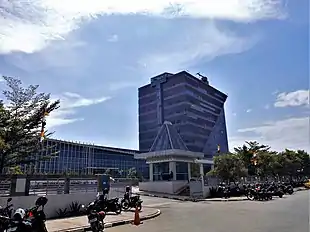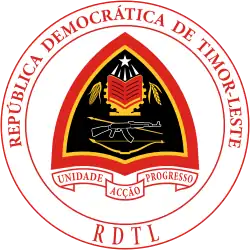Economy of East Timor
The economy of East Timor is a low-income economy as ranked by the World Bank.[12] It is placed 133rd on the Human Development Index, indicating a medium level of human development.[13] 20% of the population is unemployed,[1] and 52.9% live on less than $1.25 a day.[13] About half of the population is illiterate.[13] At 27%, East Timor's urbanisation rate is one of the lowest in the world.
 | |
| Currency | US dollar (USD) and East Timor centavos[1] |
|---|---|
| Calendar year | |
Trade organisations | Pacific Alliance |
Country group |
|
| Statistics | |
| GDP | [4] |
GDP growth | |
GDP per capita | [4] |
GDP by sector |
|
| 2.294% (2018)[4] | |
Population below poverty line | 49.9%[6] (2007 est.) |
| 38 (2002 est.) | |
Labour force | 430,200 (2009) |
| Unemployment | 18% (2010 est.) |
Main industries | printing, soap manufacturing, handicrafts, woven cloth |
| External | |
| Exports | $24 million (2017 est; excludes oil) |
Export goods | coffee, sandalwood, marble; |
Main export partners |
|
| Imports | $588 million (2017 est.) |
Import goods | food, gasoline, kerosene, machinery |
Main import partners | |
Gross external debt | |
| Public finances | |
Foreign reserves | $279,000,000 (December 2013) |
All values, unless otherwise stated, are in US dollars. | |
In 2007, a bad harvest caused a "major food crisis" in East Timor. By November, eleven sub-districts still needed food supplied by international aid.[14]
According to data gathered in the 2010 census, 87.7% of urban and 18.9% of rural households have electricity, for an overall average of 36.7%.[15]
History
Prior to and during colonisation, the island of Timor was best known for its sandalwood. The Portuguese colonial administration also granted concessions to Oceanic Exploration Corporation to develop oil and gas deposits. However, this was curtailed by the Indonesian invasion in 1976.
Petrochemical resources were divided between Indonesia and Australia with the Timor Gap Treaty in 1989.[16] The treaty established guidelines for joint exploitation of seabed resources in the area of the "gap" left by then-Portuguese Timor in the maritime boundary agreed between the two countries in 1972.[17] Revenues from the "joint" area were to be divided 50-50. Woodside Petroleum and ConocoPhillips began development of some resources in the Timor Gap on behalf of the two governments in 1992.
In late 1999, about 70% of the economic infrastructure of East Timor was destroyed by Indonesian troops and anti-independence militias,[1] and 260,000 people fled westward. From 2002 to 2005, an international program led by the United Nations, manned by civilian advisers, 5,000 peacekeepers (8,000 at peak) and 1,300 police officers, substantially reconstructed the infrastructure. By mid-2002, all but about 50,000 of the refugees had returned.
Data
| Year | GDP (in mil. US$ Nominal)[18] |
GDP per capita (in US$ Nominal)[19] |
GDP growth (real) |
GDP per capita growth (real) |
Inflation rate (in %) |
Government debt (in % of GDP) |
Note |
|---|---|---|---|---|---|---|---|
| 1993[20] | non-oil | ||||||
| 1994[20] | non-oil | ||||||
| 1995[20] | non-oil | ||||||
| 1996[20] | non-oil | ||||||
| 1997[20] | non-oil | ||||||
| 1998[20] | Indonesian economic crisis | ||||||
| 1999 | Independence | ||||||
| 2000 | |||||||
| 2001 | |||||||
| 2002 | |||||||
| 2003 | |||||||
| 2004 | |||||||
| 2005 | |||||||
| 2006 | |||||||
| 2007 | oil economy start | ||||||
| 2008 | |||||||
| 2009 | |||||||
| 2010 | |||||||
| 2011 | |||||||
| 2012 | |||||||
| 2013 | |||||||
| 2014 | |||||||
| 2015 | |||||||
| 2016 | |||||||
| 2017 | oil price decline | ||||||
| 2018 | |||||||
| 2019 | |||||||
| 2020 | |||||||
| 2021 |
Industries
Agriculture
The country has a developed agricultural sector. Coffee, rice, maize, coconuts, cassava, soybeans, bananas, mango, and sweet potatoes are cultivated here.
Energy
Electricity
Electricidade De Timor-Leste (EDTL) is the vertically integrated monopoly generator and distributor of electric power within the on-grid areas.
Tourism
In 2017, the country was visited by 75,000 tourists.[21] Since the later 2010s, tourism has been increasing and the number of hotels and resorts has increased. The government decided to invest in the expansion of the international airport in Dili.
Transport
Development projects
Electricity
Oil and gas

One promising long-term project is the joint development with Australia of petroleum and natural gas resources in the waters southeast of East Timor.
East Timor inherited no permanent maritime boundaries when it gained independence, repudiating the Timor Gap Treaty as illegal. A provisional agreement (the Timor Sea Treaty, signed when East Timor became independent in 2002) defined a Joint Petroleum Development Area (JPDA), and awarded 90% of revenues from existing projects in that area to East Timor and 10% to Australia.[22] The first significant new development in the JPDA since East Timorese independence is the largest petroleum resource in the Timor Sea, the Greater Sunrise gas field. Its exploitation was the subject of separate agreements in 2003 and 2005. Only 20% of the field lies within the JPDA and the rest in waters not subject to the treaty (though claimed by both countries). The initial, temporary agreement gave 82% of revenues to Australia and only 18% to East Timor.[23]
The government of East Timor has sought to negotiate a definite boundary with Australia at the halfway line between the countries, in accordance with the United Nations Convention on the Law of the Sea. The government of Australia preferred to establish the boundary at the end of the wide Australian continental shelf, as agreed with Indonesia in 1972 and 1991. Normally a dispute such as this would be referred to the International Court of Justice or the International Tribunal for the Law of the Sea for an impartial decision,[24] but the Australian government had withdrawn from these international jurisdictions (solely on matters relating to maritime boundaries) shortly before East Timorese independence.[25]
Nevertheless, under public and diplomatic pressure, the Australian government offered instead a last-minute concession solely on royalties from the Greater Sunrise gas field.[26] An agreement was signed in 2005 under which both countries would set aside the dispute over the maritime boundary, and East Timor would receive 50% of the revenues (estimated at A$26 billion or about US$20 billion over the lifetime of the project)[27] from the Greater Sunrise development. Other developments within waters claimed by East Timor but outside the JPDA (Laminaria-Corallina and Buffalo) continue to be exploited unilaterally by Australia, however.[28]
Some proceeds from East Timor's petroleum royalties are directed to the country's sovereign wealth fund, the Timor-Leste Petroleum Fund.
Telecoms
References
- East Timor. The World Factbook. Central Intelligence Agency.
- "World Economic Outlook Database, April 2019". IMF.org. International Monetary Fund. Retrieved 29 September 2019.
- "World Bank Country and Lending Groups". datahelpdesk.worldbank.org. World Bank. Retrieved 29 September 2019.
- "World Economic Outlook Database, April 2021". IMF.org. International Monetary Fund. Retrieved 28 July 2021.
- "Budget, January 2022" (PDF). www.mof.gov.tl/. Timor Leste. p. 74. Retrieved 11 January 2022.
- Timor Leste Archived 14 August 2015 at the Wayback Machine, The World Bank data
- "Poverty headcount ratio at $1.90 a day (2011 PPP) (% of population) - Timor Leste | Data". data.worldbank.org. Retrieved 16 October 2020.
- "Poverty headcount ratio at $3.20 a day (2011 PPP) (% of population) - Timor Leste | Data". data.worldbank.org. Retrieved 16 October 2020.
- "Poverty headcount ratio at $5.50 a day (2011 PPP) (% of population) - Timor Leste | Data". data.worldbank.org. Retrieved 16 October 2020.
- "Human Development Index (HDI)". hdr.undp.org. HDRO (Human Development Report Office) United Nations Development Programme. Retrieved 11 December 2019.
- "Inequality-adjusted Human Development Index (IHDI)". hdr.undp.org. HDRO (Human Development Report Office) United Nations Development Programme. Retrieved 11 December 2019.
- Timor Leste – World Bank Archived 8 November 2016 at the Wayback Machine
- "- Human Development Reports". Retrieved 4 March 2015.
- Voice of America, 24.06.07, East Timor Facing Food Crisis Archived 14 July 2007 at the Wayback Machine and Ministry of Agriculture, Forestry and Fisheries of Timor-Leste.
- "Highlights of the 2010 Census Main Results in Timor-Leste" (PDF). Direcção Nacional de Estatística. Archived from the original (PDF) on 28 September 2013.
- "TIMOR GAP TREATY between Australia and the Republic of Indonesia on the Zone of cooperation in an area between the Indonesian Province of East Timor and Northern Australia". Archived from the original on 16 June 2005.
- "Radio Australia". Archived from the original on 2 January 2007.
- "Timor Leste GDP world bank". data.worldbank.org. Retrieved 8 April 2022.
- "Timor Leste GDP Percapita world bank". data.worldbank.org. Retrieved 8 April 2022.
- GROSS DOMESTIC PRODUCT EAST TIMOR 2000 (PDF). Boston: BOSTON INSTITUTE FOR DEVELOPING ECONOMIES. 2013.
- "Keine Lust auf Massentourismus? Studie: Die Länder mit den wenigsten Urlaubern der Welt". TRAVELBOOK. 10 September 2018.
- "aph.gov.au". aph.gov.au. Archived from the original on 4 June 2011. Retrieved 28 March 2010.
- transparency.gov.tl
- "Plain facts about". Retrieved 4 March 2015.
- "Declaration under the Statute of the International Court of Justice concerning Australia's acceptance of the jurisdiction of the International Court of Justice (Canberra, 21 March 2002) [2002] ATS 5". Retrieved 4 March 2015.
- "Downer's spin and the East Timor talks". Archived from the original on 1 December 2005.
- Geoff A. McKee, oil and gas expert engineer, Lecturer, University of NSW, Sydney, Australia. "canb.auug.org.au". canb.auug.org.au. Retrieved 28 March 2010.
{{cite web}}: CS1 maint: multiple names: authors list (link) - "pm.gov.tp". pm.gov.tp. Archived from the original on 15 June 2011. Retrieved 28 March 2010.
Further reading
- Mats Lundahl and Fredrik Sjöholm. 2019. The Creation of the East Timorese Economy. Springer.
- McDonald, Hamish (5 October 2020). "Sun is setting on Timor-Leste's pipe dream". Asia Times. Retrieved 22 February 2022.
- "Timor-Leste Tourism Research and Development" (PDF). International Labour Organization. June 2014.
